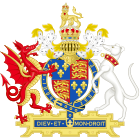Treason Act 1536 facts for kids
| Act of Parliament | |

|
|
| Long title | An Acte concernyng the Attaynder of the Lord Thomas Howard. |
|---|---|
| Citation | 28 Hen. 8. c. 24 (Ruffhead: c. 18) |
| Other legislation | |
| Repealed by | Statute Law (Repeals) Act 1977 |
|
Status: Repealed
|
|
The Treason Act 1536 (28 Hen. 8. c. 24) was an important law. It was passed by the English Parliament when King Henry VIII of England was ruling. This law made it a very serious crime, called high treason, to marry or get engaged to certain members of the King's family without his written permission.
This included the King's children, sisters, aunts, nieces, or nephews. It was also treason if these family members took part in such a marriage without permission. The law aimed to protect the royal family and the King's power.
What the Law Did
The Attainder of Lord Thomas Howard Act 1536 had specific rules. It made sure that royal family members could not marry just anyone. The King wanted to control who married into his family. This was important for keeping the royal family strong.
Why This Law Was Made
In those times, marriages were often about power and alliances. King Henry VIII wanted to make sure that any marriages involving his family helped his kingdom. He did not want marriages that could cause problems or weaken his rule. This law was a way for him to keep control.
When the Law Ended
The Treason Act 1536 did not last forever. It was later cancelled by another law. This happened in 1547, during the first year that Henry's son, Edward VI, became King. The new law was called the Treason Act 1547.
See also
- High treason in the United Kingdom

